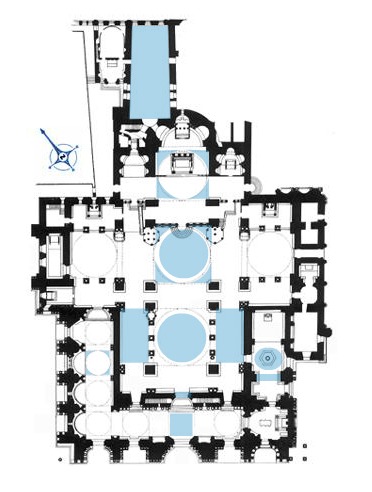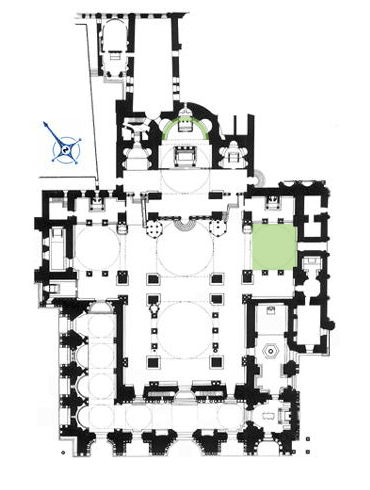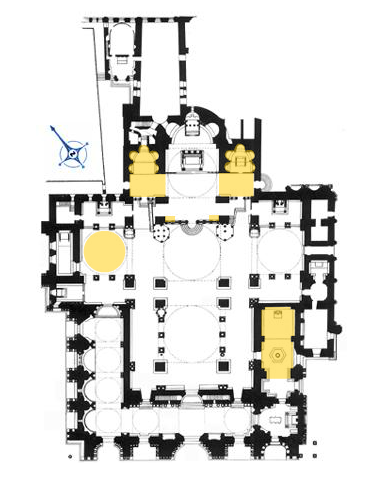Among the various themes dealt with in the church mosaics, the hagiographic cycles dedicated to Saints are of special importance. Apart from St. Mark the evangelist the hagiographic mosaics regard other saints who may be grouped as follows:
– The Apostles and the Evangelists;
– The Fathers of the Church (eastern and western);
– Some major Saints (St. Peter, St. John the Evangelist, St. John the Baptist, St. Isadore, St. Clement);
– Some Saints linked to Venice.

Apostles and Evangelists
The Apostles, like the Evangelists, appear in several mosaic cycles.
Around the portal, in niches of different sizes, there are mosaic figures of the Virgin and Child with eight Apostles in the upper register (St. Peter, St. James, St. Simon, St. Phillip, St. Paul, St. Andrew, St. Thomas and St. Bartholomew) and four Evangelists in the lower register (St. Matthew, St. Mark, St. Luke and St. John). The Evangelist are repeated in the atrium, in the “pozzo” spandrels in a Renaissance execution.
The Evangelists appear not only on the spandrels of the Prophets and Ascension cupolas, and Moses cupola in the atrium, but also on the arch underside between the Baptistery Antechamber and the Baptistery. The Apostles also appear in the Baptistery, in particular in the cupola above the baptismal font where there is a mosaic portraying Christ sending the Apostles to baptise the peoples.
They are also in the Ascension and Pentecost cupolas and the north and south vault of the Ascension cupola along the nave where their martyrdoms are depicted.
The Fathers of the Eastern and Western Church
Two Eastern Church Fathers are portrayed in the vault pier abutments in St. Clement’s Chapel: St. John Chrysostom and St. Gregory of Nazianzus, and again in the Baptistery above the baptismal font: St. Anastasius, St. John Chrysostom, St. Gregory of Nazianzus and St. Basil. The Western Church Fathersappear in the Baptistery, on the spandrels of the cupola above the altar: St. Ambrose, St. Gregory, St. Augustine and St. Jerome. They are again portrayed on the spandrels of the cupola of St. John.
The Baptistery
The figure of St. John The Baptist features in the Baptistery mosaics where all the episodes of the saint’s life are portrayed: from the angel’s message to St. Zechariah to the baptism of Christ, the saint’s decapitation and lastly his burial.
Cupola of St. John the Evangelist
The Stories from the Life of St. John the Evangelist are illustrated in the north cupola dedicated to him.
Chapels of St. Clement and St. Peter
The stories of St. Peter and St. Clement depicted on their chapels at the sides of the presbytery are ascribable to Greek craftsmen active in the upper Adriatic area during the first half of the12th century.
The presence of stories of St. Clement, pope, on the lower side of the right tribune flanking the presbytery is perhaps due to the importance of the cult of this saint, formerly linked in Alexandria with that of St. Mark who was worshipped by seafarers. The chapel of St. Clement features a great figure of the saint in the bowl-vault.
The decoration of St. Peter’s chapel involves the apse bowl-vault, with an image of the saint, the north wall and the wall opening towards the chancel.
 Venice Patron Saints
Venice Patron Saints
Cupola of St. Leonard
Saints Leonard, Blaise, Clement and Nicholas might be defined as “political” for their role in connection with the Doge.
Leonard of Limoges, holy king, indicated a manner of government based on holiness of behaviour with one’s subjects. Nicholas, saint of the sea, bound Venice to the Adriatic and Aegean territories where he was widely worshipped. Clement, the third pope, indicated the Venetian rulers’ attention to and respect for the papacy. Moreover the saint had preached in Alexandria, invited by the Apostle Peter. Blaise was one of the saints worshipped in the territories with which the Repubblica Serenissima had ongoing relations.
The chapels of St. Peter, St. Mark and St. Clement recreated in Venice the historic structure of the Church of Alexandria. Venice was heir to the latter church and to that of Aquileia-Grado in an ideal marriage of East and West. The spandrels of the cupola of St. Leonard depict the Grado female saints: Euphemia,Dorothea, Thekla and Erasma.
